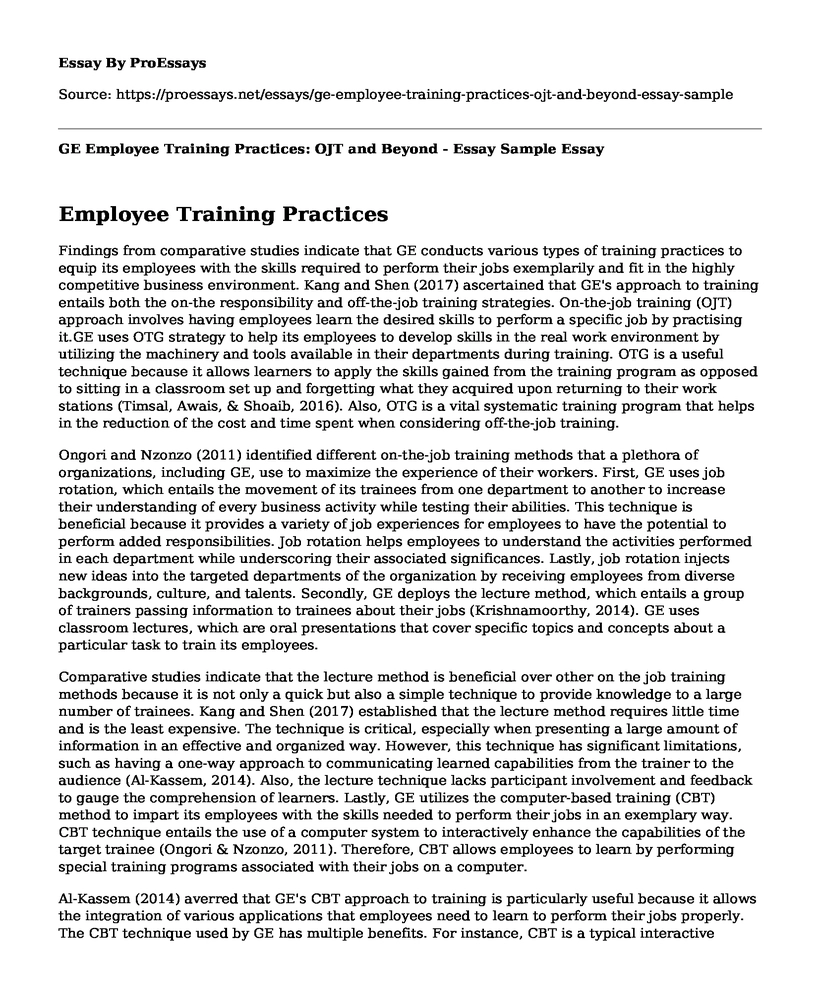Employee Training Practices
Findings from comparative studies indicate that GE conducts various types of training practices to equip its employees with the skills required to perform their jobs exemplarily and fit in the highly competitive business environment. Kang and Shen (2017) ascertained that GE's approach to training entails both the on-the responsibility and off-the-job training strategies. On-the-job training (OJT) approach involves having employees learn the desired skills to perform a specific job by practising it.GE uses OTG strategy to help its employees to develop skills in the real work environment by utilizing the machinery and tools available in their departments during training. OTG is a useful technique because it allows learners to apply the skills gained from the training program as opposed to sitting in a classroom set up and forgetting what they acquired upon returning to their work stations (Timsal, Awais, & Shoaib, 2016). Also, OTG is a vital systematic training program that helps in the reduction of the cost and time spent when considering off-the-job training.
Ongori and Nzonzo (2011) identified different on-the-job training methods that a plethora of organizations, including GE, use to maximize the experience of their workers. First, GE uses job rotation, which entails the movement of its trainees from one department to another to increase their understanding of every business activity while testing their abilities. This technique is beneficial because it provides a variety of job experiences for employees to have the potential to perform added responsibilities. Job rotation helps employees to understand the activities performed in each department while underscoring their associated significances. Lastly, job rotation injects new ideas into the targeted departments of the organization by receiving employees from diverse backgrounds, culture, and talents. Secondly, GE deploys the lecture method, which entails a group of trainers passing information to trainees about their jobs (Krishnamoorthy, 2014). GE uses classroom lectures, which are oral presentations that cover specific topics and concepts about a particular task to train its employees.
Comparative studies indicate that the lecture method is beneficial over other on the job training methods because it is not only a quick but also a simple technique to provide knowledge to a large number of trainees. Kang and Shen (2017) established that the lecture method requires little time and is the least expensive. The technique is critical, especially when presenting a large amount of information in an effective and organized way. However, this technique has significant limitations, such as having a one-way approach to communicating learned capabilities from the trainer to the audience (Al-Kassem, 2014). Also, the lecture technique lacks participant involvement and feedback to gauge the comprehension of learners. Lastly, GE utilizes the computer-based training (CBT) method to impart its employees with the skills needed to perform their jobs in an exemplary way. CBT technique entails the use of a computer system to interactively enhance the capabilities of the target trainee (Ongori & Nzonzo, 2011). Therefore, CBT allows employees to learn by performing special training programs associated with their jobs on a computer.
Al-Kassem (2014) averred that GE's CBT approach to training is particularly useful because it allows the integration of various applications that employees need to learn to perform their jobs properly. The CBT technique used by GE has multiple benefits. For instance, CBT is a typical interactive technology, which plays a vital role in reducing the learning time by an average of 50% (Jehanzeb & Bashir, 2013). Also, CBT is cost-effective upon design and production because it provides instructional consistency, and encourages employees to master the skills learnt. Lastly, CBT increases the retention capacity of the organization and enhances the motivation of trainees, which in turn leads to higher performance. Off the job training, on the other hand, refers to the training technique in which employees learn their job roles away from the actual work floor (Elnaga & Imran, 2013). As a result, employees may take study leaves and academic vacations to attend various learning programs to grow their skills, knowledge, and experience.
According to Kulkarni (2013), contemporary organizations prefer funding their employees for various study programs away from their workstations to increase their job performance capacity. For instance, GE became the first organization in the world to put up a cooperate university dedicated to providing high-quality employee learning and training services. The university trains GE's employees in three different courses; executive development, business management and management development (Khan, Khan, & Khan, 2011). These courses are highly useful in developing the skills, knowledge, and attitude of employees while keeping them motivated and dedicated to achieving the company's target goals. In general, GE's off the job training approach has a pletho...
Cite this page
GE Employee Training Practices: OJT and Beyond - Essay Sample. (2023, Mar 27). Retrieved from https://proessays.net/essays/ge-employee-training-practices-ojt-and-beyond-essay-sample
If you are the original author of this essay and no longer wish to have it published on the ProEssays website, please click below to request its removal:
- Organization Theory, Behavior, Organic Organization, Mechanic Organization Mission and Vision Statement
- Organizations and Globalization Essay Example
- Upholding HR Relevance: The Key to Business Success - Essay Sample
- Essay on Consumers' Pursuit of Sustainable Food Products: A New Era in the Food Industry
- Essay Example on Gold: Precious Metal Riding High in Global Market Despite Recession
- Essay Example on Developing Employability Skills for Efficient Employee Performance
- Paper on Interns Should Be Paid For Their Work







